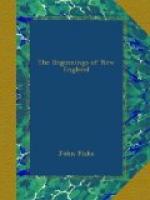In the spring of 1638 the town of New Haven was accordingly founded. The next year a swarm from this new town settled Milford, while another party, freshly arrived from England, made the beginnings of Guilford. In 1640 Stamford was added to the group, and in 1643 the four towns were united into the republic of New Haven, to which Southold, on Long Island, and Branford were afterwards added. As being a confederation of independent towns, New Haven resembled Connecticut. In other respects the differences between the two reflected the differences between Davenport and Hooker; the latter was what would now be called more radical than Winthrop or Cotton, the former was more conservative. In the New Haven colony none but church-members could vote, and this measure at the outset disfranchised more than half the settlers in New Haven town, nearly half in Guilford, and less than one fifth in Milford. This result was practically less democratic than in Massachusetts where it was some time before the disfranchisement attained such dimensions. The power of the clergy reached its extreme point in New Haven, where each of the towns was governed by seven ecclesiastical officers known as “pillars of the church.” These magistrates served as judges, and trial by jury was dispensed with, because no authority could be found for it in the laws of Moses. The legislation was quaint enough, though the famous “Blue Laws” of New Haven, which have been made the theme of so many jests at the expense of our forefathers, never really existed. The story of the Blue Laws was first published in 1781 by the Rev. Samuel Peters, a Tory refugee in London, who took delight in horrifying our British cousins with tales of wholesale tarring and feathering done by the patriots of the Revolution. In point of strict veracity Dr. Peters reminds one of Baron Munchausen; he declares that the river at Bellows Falls flows so fast as to float iron crowbars, and he gravely describes sundry animals who were evidently cousins to the Jabberwok. The most famous passage of his pretended code is that which enacts that “no woman shall kiss her child on the Sabbath,” and that “no one shall play on any instrument of music except the drum, trumpet, or jewsharp.” [Sidenote: Legend of the “Blue Laws”]
When the Long Parliament met in 1640, the Puritan exodus to New England came to an end. During the twenty years which had elapsed since the voyage of the Mayflower, the population had grown to 26,000 souls. Of this number scarcely 500 had arrived before 1629. It is a striking fact, since it expresses a causal relation and not a mere coincidence, that the eleven years, 1629-1640, during which Charles I. governed England without a parliament, were the same eleven years that witnessed the planting of New England. For more than a century after this there was no considerable migration to this part of North America. Puritan England now found employment for all its energies and all its enthusiasm at home.




